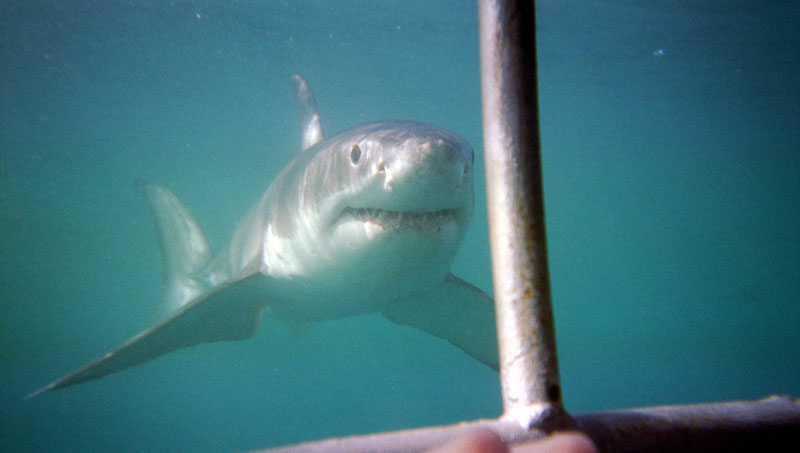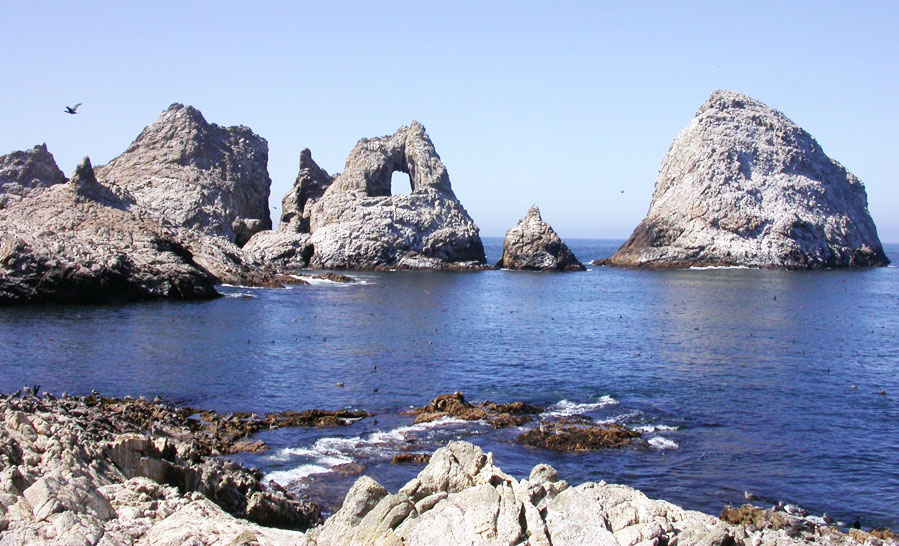As I pull an 8 mm wetsuit over my knees and shoulders, my stomach grumbles with anxiety. The deckhand helps me strap five-pound weights to my ankles as we drop anchor at the Farallon Islands off the coast of San Francisco. The water is a chilling 50 degrees, but I’ve wanted to go cage diving with Great White sharks for years, so I clinch down on my regulator, hold my mask to my face and suck it up. It’s like jumping into a world you know you’re not supposed to be in, but visit anyway, hoping that you’ll face your fears eye to eye. Submerged approximately 10 feet below the surface, the steel cage evokes more claustrophobia in me than anything else, but it quickly becomes my comfort zone. I’m not afraid to see a shark; in fact, I’m excited. Once I adjust to the hookah system and can comfortably wrap my hands around the bars in front of me, I begin scanning the depths below for jaws.
Growing up in Marin County, shark sightings were an ordinary occurrence each summer. It was normal to see warning signs posted at Stinson Beach. Although there is rarely more than one attack per year, I learned a great deal of shark safety advice at an early age. Always swim with a buddy. Avoid seal rookeries. Don’t surf alone. Keep your heart rate down when scuba diving. Never go in the water if you have an open wound. If attacked, punch the shark on its nose or eyes where it’s most sensitive. Or, as one victim did, rip at its gills. Basically, when attacked, fight back. However, the shark’s monster reputation – undoubtedly influenced by media – has instilled more curiosity in me than fear, so I’ve taken notes over the years.
Of California’s 33 million residents, 80% live within 50 kilometers of the Pacific Ocean,[i] and there have only been 8 fatal shark attacks in California since 1926.[ii] Most of these attacks have resulted from blood loss or shock. Typically, sharks will give an open mouth punch to identify an object, which supports the theory that majority of attacks occur by accident. They also posses the innate ability to sense electromagnetic fields, which is why they are particularly attracted to distressed prey and not falling for our rubber decoys. Most sharks also must continue to move in order to breath, especially Great Whites. Circling other living creatures seems to occur out of general curiosity, not necessarily because they’re looking for the best angle of attack. I’ve actually found that sharks are quite vigilant and easy to spook away, but so long as there is an active heartbeat nearby, they want to know what it’s all about. Then again, isn’t that the same reason I’m in this cage: to learn what white sharks are all about?
In The Devil’s Teeth,a short documentary by San Francisco filmmaker Roger Teich, California urchin diver Ron Elliot reveals what it’s like to free dive with white sharks. He explains, “You can almost touch them and they won’t even flinch because you’re just part of the background. They’re passing by you, but that’s not why they came by.”[iii]
I glance down at my watch and realize I’ve been underwater for thirty minutes. If Great Whites were man-eaters, you’d think they’d have checked me out by now, but there are none in sight. For centuries, white sharks have been portrayed as vindictive, man-eating machines with razor sharp teeth; naturally, the public grew obsessed with loathing them. That’s not to say these predators are not capable of such attacks on humans, but how many of us have actually touched a shark, much less seen one outside of the Discovery Channel’s annual shark week series?

Before my second scuba dive, our skipper Captain Mick shares a story of how he witnessed a killer whale attacking and feeding on a Great White back in 1998, right here at the Farallones. The orca t-boned the shark, turned it over and held it by its neck until it suffocated. The whale then preceded to playfully feast on its liver with two other family members from the increasingly popular L.A. Pod. As most shark enthusiasts know, sharks are put in a hypnotic state when positioned upside down, but for Great Whites the potential consequences are deadly. Additionally, scientists have recently found that the best shark repellent is the smell of another dead shark, as highlighted in a close study on tonic immobility in National Geographic’s The Whale that Ate Jaws.[iv]
Man has also recently proved himself a threat to worldwide shark populations. In an effort to feed the demand for shark fin soup in China, an estimated 80-100 million sharks are killed each year.[v] In parts of Latin America, including Cocos Island and the Galapagos, Japanese fishermen have been fishing sharks from their habitats – mostly illegally – at incremental rates. Shark fin is considered a delicacy throughout Asia, and a symbol of wealth and affluence. The soup is often served at weddings and special events. A standard sized dorsal fin can be worth a few hundred US dollars, but sharks fins (and meat) also contain high amounts of mercury that increase in toxicity with the size of the shark. The fins are cut off when caught, dried in the sun, and shipped to be sold as a chewy ingredient, though it is purely for texture as they are tasteless.[vi] In order to gain the highest possible profit in one outing, fishermen seeking this coveted cartilage stay at sea as long as they can and seek out ways to make more room on the boat. They catch the sharks, remove the fins and return the bodies to the water alive, without a means of propulsion leading to suffocation. Vegetarian substitutes for shark fins exist, but the recipe alternative has yet to catch on. As the consumer demand for the fins continues, so does a substantial increase in fishing pressure.
In summary, people enjoy fearing sharks, but if sharks are – for the most part – harmless, why does our culture point to them as viscous marine predators? Millions of people across the world interact with the ocean every day, yet only approximately 5 fatal shark attacks occur annually worldwide.[vii] In 2009, more people were killed from being crushed by soda machines than were killed by shark attacks. Without their role in marine ecosystems, not only would seafood markets suffer, but coral reefs are said to go extinct in twenty years[viii] if continued at their current depleting rate.
After two lackluster scuba diving attempts at an underwater shark sighting, we gear up to leave. The radio notifies Captain Mick of an attack on an elephant seal nearby, so we power the motors and are there within minutes. Then, I spot her. A massive 18-foot long female passes alongside our boat. She glances up at me as she swims by on her side, easily the size of our boat and seemingly more inquisitive than aggressive. It is only a few moments of interaction, but it is enough to confirm that sharks are intelligent. And even though they’re prehistoric, we still know very little about them, including how they mate or where they give birth. Perhaps diving with sharks is not a adrenaline rush, but rather a great joy to view these magnificent, complex animals in their natural habitat. I’d go back, and if I do, perhaps next time my stomach will cooperate.
Words by Lauren de Remer
http://www.youtube.com/watch?v=40OFCTe-mDU
[ii] http://www.flmnh.ufl.edu/fish/sharks/statistics/GAttack/mapCA.htm
[iii] http://www.youtube.com/watch?v=OfyVbqS7W-M
[iv] http://www.youtube.com/watch?v=3uBFUumm3Dk
[v] http://www.sharkwater.com/education.htm
[vi] http://www.cnn.com/2008/WORLD/asiapcf/12/10/pip.shark.finning/index.html
[vii] http://www.thescubasite.com/Scuba-Diving-Resources/where-shark-attacks-happen
[viii] http://www.cbsnews.com/stories/2010/03/26/tech/main6335364.shtml

